Straddling the Pacific and Australian tectonic plates, New Zealand is littered with active fault lines that have shaped its unique, colourful landscape. A hotbed of geothermal and volcanic activity, the north island offers a glimpse into the tempestuous nature of life deep within our earth.
Vagabondish is reader-supported. When you buy through links on our site, we may earn a small affiliate commission. Read our disclosure.
Once part of a larger super continent the New Zealand we see today is the product of a constant collision of super-heated rock forcing the earth’s surface towards the sky. While earth-shattering quakes are not uncommon many are confined deep beneath the ocean where the two plates are in relentless conflict.
Despite the fact much of New Zealand’s alluring landscape is a product of the turbulent fire deep within its heart, there are areas of activity observable to those adventurous enough to visit.
A volcanic triangle connecting Rotorua, the mountains of Tongariro National Parkand and the Bay of Plenty forms the Taupo volcanic zone. Home to numerous volcanic vents and areas of geothermal activity this region of powerful natural beauty can be explored over land, by sea and from the air.
Discovering a Geothermal Wonderland
The literal translation of the word geothermal is ”˜earth heat’ and if I used just two words to describe the Wai-O-Tapu geothermal reserve they would be top of my list. In its most basic format the theory which explains the elemental activity throughout the reserve is that heat from within the earth escapes to the surface cultivating a mineral rich environment.
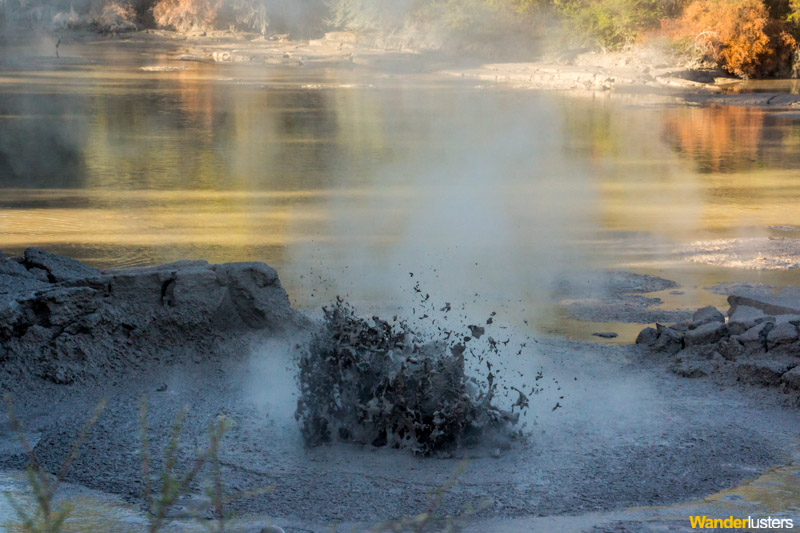
Boiling Mud at Wai-O-Tapu, Rotorua © Wanderlusters.co.uk
The escaping heat transforms the very nature of the landscape, turning patches of inanimate land into boiling pools of inky black mud, scorching eruptions of stem and toxic colourful springs.
As one of the most alluring displays of geothermal activity in the region, it offers those with a strong constitution the chance to get up close to the environment that facilitated the first life on earth billions of years ago. A giant natural lab of chemical reactions a visit is not for those with a sensitive nose or an aversion to the more surreal life experiences.
Wai-O-Tapu Geothermal Reserve
Walking the 3km track that takes you on a whirlwind tour of primordial earth, you’re treated to more than twenty examples of geothermal activity. Deep craters set back in the rocks, tainted yellow and stinking of sulphur, invite you to lean over the guard rails for a better look. Their rough walls are tinged with a greenish hue from the cooling sulphuric vapours and ferrous salts escaping into the surrounding atmosphere.
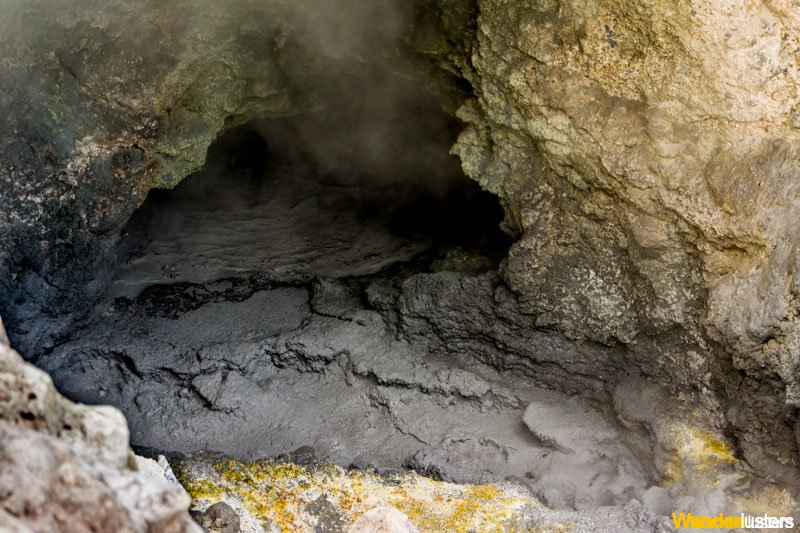
Sulphur Cave at Wai-O-Tapu, Rotorua © Wanderlusters.co.uk
A reminder of the unstable landscape the gargantuan boiling mud pools bare resemblance to a witch’s cauldron and harbour a toxic jet black potion. Aptly named ”˜The Devil’s Ink Pots’ their levels fluctuate with the varying amounts of rainfall and of course how many letters the Devil writes with his feather quill!
The Champagne Pool
The crowning glory of the reserve has to be the colourful champagne pool. Formed almost 800 years ago by a powerful hydrothermal eruption it is the largest natural spring in the area. Fed by a system of streams deep underground its waters range from a tepid 74 degrees at the surface to a flesh melting 230 degrees at the source.
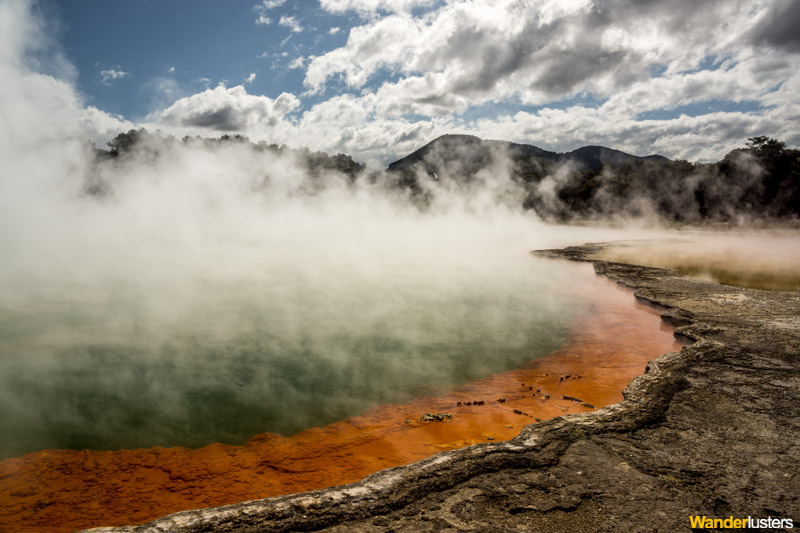
Champagne Pool, Wai-O-Tapu, Rotorua © Wanderlusters.co.uk
The high temperatures at depth facilitate a transfer of minerals into the water from the surrounding volcanic rock. As the water rises it cools and deposits its rich bounty on thick colourful ledges at the edge of the springs. The sulphuric green water, vivid orange sinter ledges and insipid yellow pools contrasts against the white plumes of acrid steam from the neighbouring Devil’s Bath.
One of the most distinctive parts of New Zealand’s landscape Wai-O-Tapu is not to be missed. While other geothermal attractions in the local area have chosen to exploit the natural environment — we heard that one of the larger geysers is pumped full of water and aggravated with a substance similar to washing powder to force it to erupt with additional vigour — Wai-O-Tapu appeared to concern itself less with financial gain and more with preserving this fragile example of New Zealand’s geothermal soul.
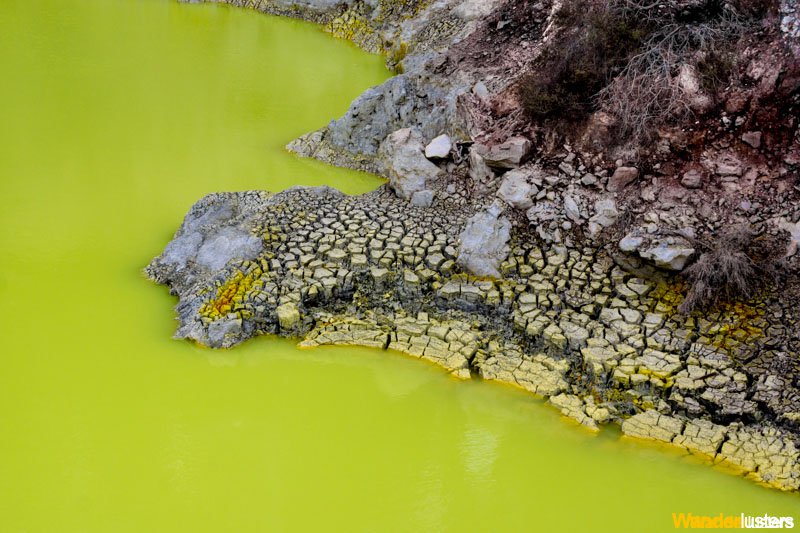
Devil's Bath, Wai-O-Tapu, Rotorua © Wanderlusters.co.uk
White Island – the Dramatic Volcano
If you’re inspired by the colourful geothermal activity over at Wai-O-Tapu then brace yourself for the mind boggling scale of volcanic commotion on White Island. New Zealand’s only active marine volcano a visit to the crater floor of this submarine giant offers the more adventurous traveller a chance to test their nerve.
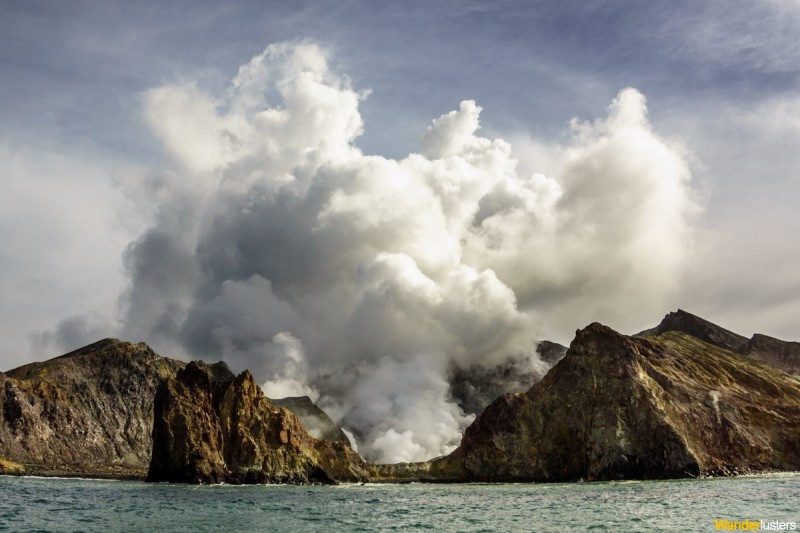
White Island, New Zealand © Wanderlusters.co.uk
49km from the shores of New Zealand’s north island and at the outer edge of the Taupo volcanic zone sits Whakaari, or White Island as it is more commonly known.
Discovered first by the Maui settlers over 1000 years ago and later by Captain Cook and his crew, this mass of volcanic power has shadowed New Zealand’s eastern shores for over 200,000 years. Wielding the eruption capacity to demolish the neighbouring Bay of Plenty with a tsunami that would wipe out many of the coastal towns and cities, the volcano is constantly monitored by a team of dedicated scientists.
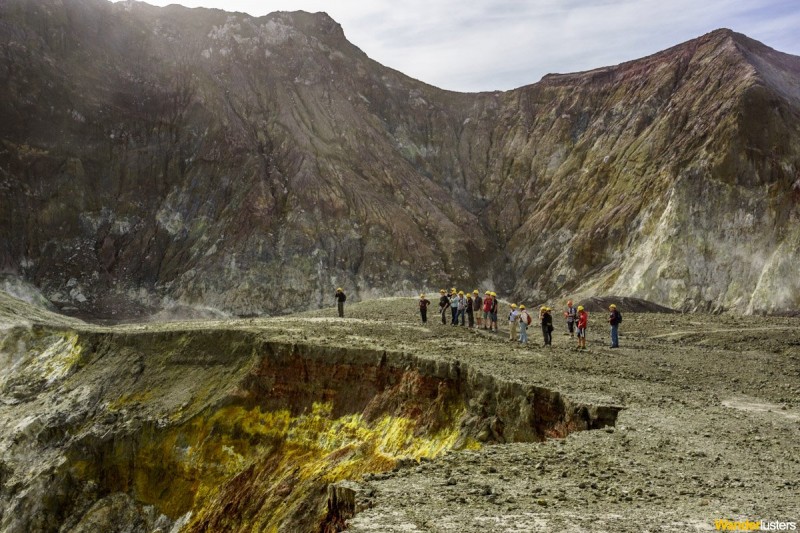
White Island, New Zealand © Wanderlusters.co.uk
Inside An Active Volcano
A 90-minute boat ride will get you out to the protected shores of Whakaari and clad in your mandatory yellow hard hat and gas mask you’ll be guided through the lunar landscape into the crater of the active volcano. Yes, that was not a typo, it is possible to hike across the crater floor of a powerful active volcano.
Gargantuan plumes of steam rise from the centre of the great lake and the igneous rock crunches beneath your feet. All around you Mother Nature reminds you of her immeasurable influence over the ground on which you stand. The cliffs of the crater wall tower above you, tarnished with sulphuric yellows and ochre reds.
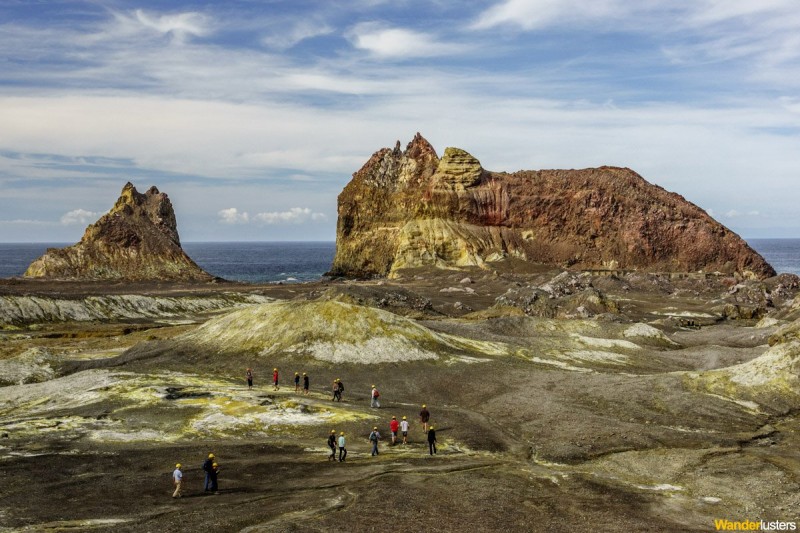
White Island, New Zealand © Wanderlusters.co.uk
Much like Wai-O-Tapu the ground offers boiling pools of mud and vents of steam but on a much larger scale. Sulphur crystals adorn the pressure mounds that release spurts of steam into the primordial atmosphere and streams of once molten volcanic rock meander across your path.
The Great Lake
In the centre of the crater lies the great lake. Fed not by the surrounding ocean but rather a cocktail of condensed gasses and rainwater, this is a lake like no other. Coloured by the ever-changing mix of minerals that make up its ”˜waters’ the lake has been known to fluctuate in colour from rich turquoise to shades of pink and orange.
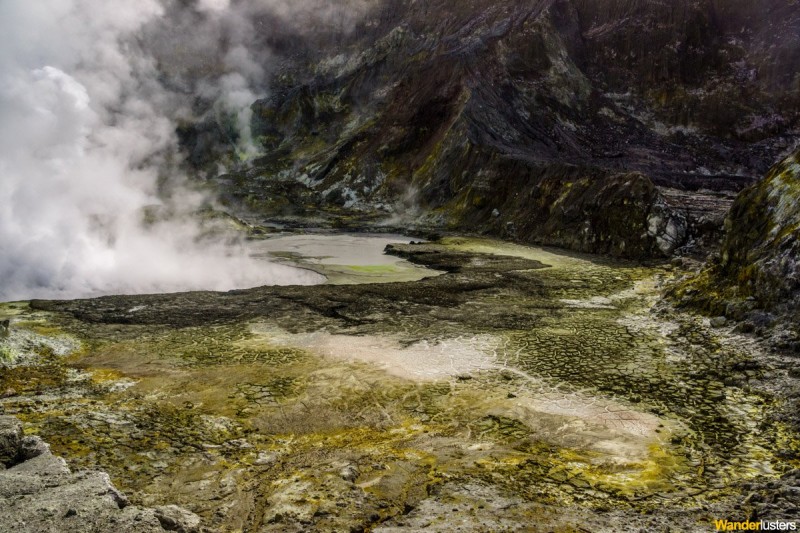
White Island, New Zealand © Wanderlusters.co.uk
Sadly the water levels are in decline and therefore the colours no longer sparkle with the same electric magnitude. As is often the case with the natural world the volcano is in a state of constant change and we remain in the dark with regard to its plan for the future.
What was once a turbulent crater filled with roaring geysers, geothermal eruptions and noxious lakes is now navigated with relative ease. Although somewhat sedate in comparison to years gone by, a visit to the crater floor takes you out of this world and into an alien landscape unlike anything you will have experienced before. If the wonderful world of geothermal activity excites the adventurer within you this is one location not to be missed.
Should you desire to experience the thrills of life on White Island from a more stable environment, pop over to the Geonet website. The official source of geological hazard information for New Zealand you can check out visual displays of recent seismic activity and watch live volcano web cameras monitoring White Island and many of the country’s other active volcanoes.
There are countless areas within the Taupo Volcanic zone that exhibit the climate of primordial earth. Once you’ve made the obligatory visit to Hobbiton I suggest you sack off the remainder of your ”˜Lord of the Rings’ inspired New Zealand itinerary and immerse yourself in a real life equivalent of Mordor.
Minus those hideous Orcs of course.


